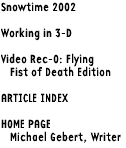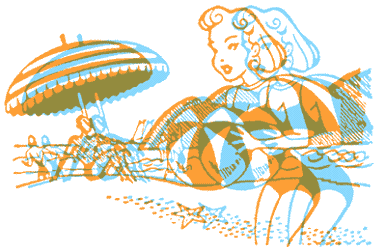


A WHILE BACK I SAW A CLEVER PROMOTION aimed at travel agents, for a winter getaway destination that had last been hot about the time Pat Boone was huge.
Instead of trying to fight that 50s image, the agency wisely decided to capitalize on Baby Boomer nostalgia for the place. So rather than send out a brochure full of color beach photos, they sent out a View-Master full of them. Cool idea, I thought, and eagerly picked up the red plastic viewer... only to discover that every single image on the reel was two-dimensional.
Okay, look, I know how these things happen. They didn’t have money for a shoot, and they couldn’t find stock that was shot in 3-D, and hey, everybody still gets the idea, right? Sure. We all get the idea—and we all get the same feeling of letdown, too.
Actually, if the creatives involved had studied their Casper comic books more closely when they were kids, they would have known how easy it is to fake 3-D—as these illustrations will prove when you look through 3-D glasses* (red left, blue right). Take one beach background, strip in a romantic couple in slightly different positions left-right, and voila!—three dimensionality. Or as much of it as you get from your average View-Master reel, anyway.

NOW, KNOWING HOW TO FAKE 3-D (the way I have here) may seem an odd requirement for a job in advertising. But I would contend that curiosity about such oddball things is the single most important requirement for the job. Only if we fill our heads with the world in all its dimensions will our minds have enough dimension to produce on demand.
It always bugs me when something turns up in a TV spot right after it was in a movie. Anybody could have the idea of using Dick Dale surf guitar in a spot after hearing “Miserlou” in Pulp Fiction, or of doing one of those freeze-and-track-360 shots after seeing The Matrix. People in advertising aren’t paid the big bucks to find out about something cool at the same time all of America discovers it at the multiplex—or, for that matter, to need Hollywood’s validation to think that it’d be cool. We’re paid to already know about things like surf guitar. To be ahead of that wave.
By being ahead of the wave, I don’t just mean being hip—although that can be part of it. We’ve all known the type of creative who specializes in being aboard the latest trend the instant it appears in the hippest magazine of the moment (formerly Raygun, now Wallpaper). Being up to the minute is a start, but if you stop there, then you’re only a minute deep.
The people who really think up the latest things don’t just obsess over what’s new. Their heads are stuffed with old stuff—that is, they’re full of everything, which by definition is 99% Not New. They may not (like one reader of this newsletter) actually keep a scrapbook of their favorite Portuguese cigarette packages of the 1970s for design inspiration. But their minds work the same way, saving everything they run across for the day it will be the perfect ingredient to drop into the cranial blender.
In the end, all we have to sell is a creative sensibility. It pays to keep that sensibility well fed with new things, and to nurture our interests and obsessions. So that at the very least, we’ll know enough to be able to fix it when somebody screws up our work and tries to tell us, “Hey, 2 out of 3-D ain’t bad.”
* P.S. Want a pair of 3-D glasses to view this page with? Contact me (while supplies last) at mike@michaelgebert.com. Or click here for lots more cool 3-D images and details on how to get a free pair by mail from Rainbow Symphony, the official 3-D Glasses supplier to Michael Gebert, Writer!